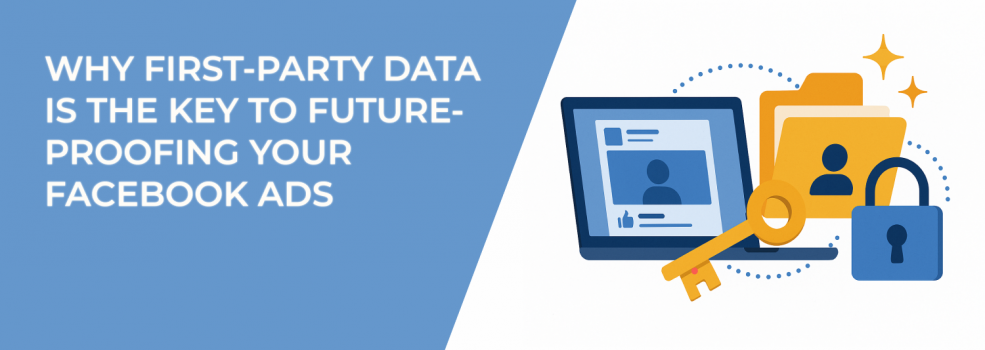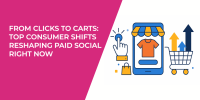Running ads on Facebook used to be simple. You set up a campaign, added some interests, and let Meta’s system do the heavy lifting. Things have changed. Privacy rules are stricter, Apple’s iOS updates limit tracking, and third-party cookies are fading out. For advertisers, this means less reliable targeting and higher costs.
The answer is first-party data — the information you collect directly from your own audience.
What Is First-Party Data?
First-party data is the data you gather yourself. Examples include:
-
Email sign-ups from your website.
-
Purchase history in your store.
-
Form submissions for demos, quotes, or downloads.
-
Reactions to polls, quizzes, and surveys.
-
On-site behavior captured via pixel events.
It’s accurate, permission-based, and unique to your brand. You’re not renting access to someone else’s audience. You’re building your own.
Example: If you run an online clothing store, your first-party data might include:
-
Customers who bought shoes in the last 90 days.
-
Newsletter subscribers who click “New Arrivals.”
-
Shoppers who added items to cart but didn’t purchase.
Each of these groups can become a laser-focused audience in Facebook Ads.
New to the foundations of audience building on Meta? Brush up with Facebook Ad Targeting 101: How to Reach the Right Audience.
Why Facebook Advertisers Need First-Party Data
CPMs are higher than they used to be. Conversions can be harder to win. When you rely only on broad interests, you pay to reach people who may never buy. First-party data changes that. It helps you focus on warm audiences — people who already raised a hand.
You also get resilience. Platforms change their rules. Data access shifts. When you own the relationship and the data, your ads stay effective through the next update and the one after that.
Want a deeper playbook for adapting to privacy changes? See Combating iOS Privacy Changes: Smart Ad Targeting Strategies for Facebook.
How to Collect First-Party Data Without Losing Trust
People share data when the value is clear. Keep it simple and respectful.
-
Offer value. Discounts, guides, early access, or bonus content.
-
Ask less up front. Start with email; enrich over time.
-
Be transparent. Say what you’ll send and how often. Make opt-out easy.
-
Use interactive formats. One-minute surveys, quizzes, or polls can reveal product preferences, budget range, or timelines.
Example prompts you can use:
-
“What size do you usually buy?”
-
“Which roast do you prefer — light, medium, dark?”
-
“Are you shopping for yourself or a gift?”
Pro tip: Quizzes that deliver a tailored recommendation convert well and create perfect segments for follow-up ads.
How to Use First-Party Data in Facebook Ads
Once you have the data, plug it into Meta’s strongest tools:
-
Custom Audiences.
Upload email lists or phone numbers to reach past buyers, high-intent leads, or subscribers. Example: show a “New Season Drop” ad to customers who purchased last fall. -
Lookalike Audiences.
Use your best customers as a seed. Start with a 1% lookalike, then test 2–3% as you scale. Example: build a lookalike of your top 500 buyers by lifetime value. -
Segmentation by behavior.
-
Cart abandoners → reminder ad with free shipping.
-
High-frequency browsers → product education or UGC.
-
High spenders → VIP bundles and early access.
-
-
Message matching across channels.
If your email announces a limited-time offer, sync a matching Facebook ad so the message follows users in the feed.
If you’re weighing audience types, this breakdown helps: Custom vs Lookalike Audiences: What Works Best for Facebook Campaigns?.
Advanced Angle: Zero-Party Data for Even Sharper Targeting
Zero-party data is information customers volunteer — preferences, budgets, timelines, style choices. It’s gold for ad relevance because it’s explicit and current. Add one or two well-placed questions to your forms or quizzes, then segment your ads by those answers.
For a forward-looking guide on this, read Zero-Party Data and Facebook Ad Targeting: The Future of Custom Audiences.
Why First-Party Data Future-Proofs Your Facebook Ads
The direction is clear: more privacy, fewer third-party signals, and more automation inside ad platforms. First-party data sets you up to win because:
-
You own the relationship and the audience.
-
Consent is built in when you collect data transparently.
-
Relevance improves, which lowers wasted spend.
-
Lifetime value grows as your messaging gets personal and timely.
Picture two brands. One relies on broad interests. The other has clean lists, fresh segments, and a steady stream of quiz responses and email sign-ups. Which one keeps performance steady when the next policy update lands?
Final Thoughts
First-party data turns Facebook Ads from guessing into knowing. Collect it with care. Use it with intention. Then let your creative and offers do the talking. Curious how far you can scale once your audiences are clean and current? You’ll find out faster than you think.

